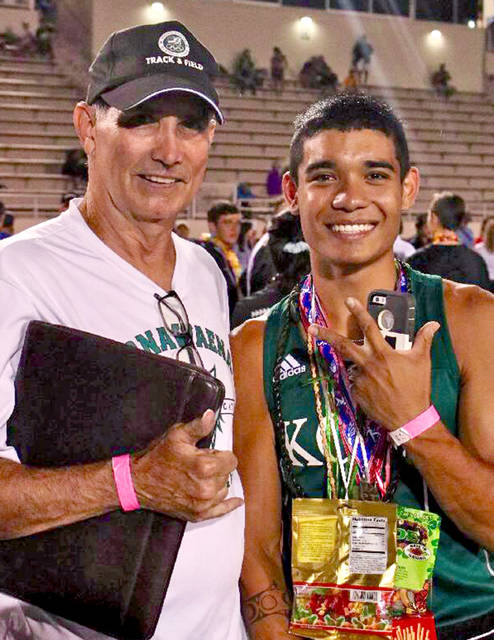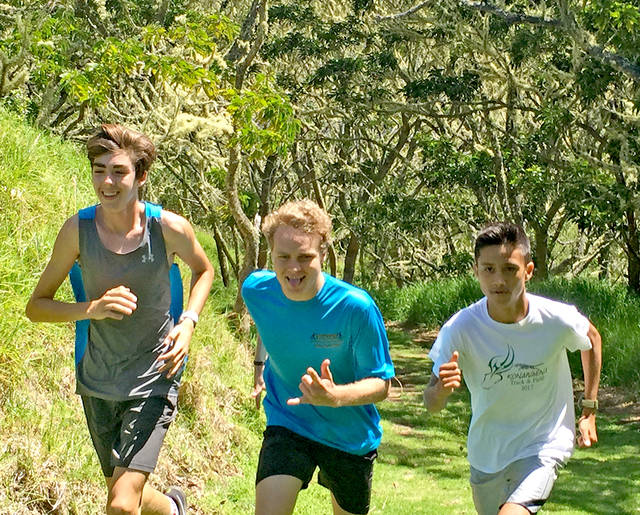Elite endurance runners around the world will swear by it.
Train your body at altitude – that is preferably 6,000 to 10,000 feet above sea level, and almost immediately, physical adaptations begin to take place.
Studies have shown that levels of EPO (erythropoietin) — a natural hormone produced by the kidneys which stimulate the formation of red blood cells by the bone marrow — spike within 24-48 hours of arriving at altitude.
And because the most important function of red blood cells are to carry fresh oxygen from the lungs to all body tissues when you breathe in, and then transport (remove) carbon dioxide back to the lungs upon exhaling, many studies have proven a direct correlation with an increase of red blood cell count to a boost in race performance.
Lasting effects can range from 10-14 days, which ultimately gives competitors an “advantage” when returning to compete at a race at sea level.
For Patrick Bradley, who coached Konawaena High School’s cross-country, and track and field teams over the last five years, the idea of training at altitude to gain a competitive edge was something he experienced first-hand as an athlete back in the 80s.
As a former collegiate all-American in track and field at Texas A&M, and a two-time Olympic Trials competitor in the 800-meter event, Bradley spent three years living at an altitude of 6,000 feet in Colorado Springs to train at the Olympic Training Center.
Bradley is credited with the success of the Wildcats’ running programs. He led the Wildcats to the school’s first HHSAA Division II cross country team championship title in 2016, while producing a BIIF cross country champion the same year. More recently, Bradley had Josiah Vallez win 800-meter run in track and field state championships this past season.
Earlier in the week, Coach Bradley shared his thoughts on the benefits of running at altitude, his training methods and passion toward helping athletes succeed, a little on his running and coaching background, and what he hopes to achieve with his new role as “head coach” for the Kealakehe High School boys and girls cross-country teams.
Q: What are the benefits of training at altitude?
By running the same velocity at sea level, when you go to altitude you expose yourself to a lower partial pressure of oxygen. In a sense, you will be running at a higher percentage of your VO2 maximal uptake. By stressing your system that way, you get a better training effect.
There are lots of altitude endurance running camps in the U.S. with most of them being in Colorado. A lot of college kids will train at altitude in the summer when the weather is good to help prepare them for the upcoming season.
It would be nice to do it all the time, but we are fortunate that I can take my runners to do it at least once a week on Mauna Kea. A lot of times I will ride my elliptical bicycle (standup bicycle) alongside my runners at altitude since I really can’t run anymore. My knees took too much of a beating so I mainly swim, bike and ride my elliptical bike. That way I get something out of the workout too.
We have three different trails that we run up on Mauna Kea. Then we have a really nice hill that we run. It’s all grass and it’s so nice, and that’s where we do our intervals.
Q: How many years have you included this type of training for your athletes? What has been the outcome?
When I started coaching cross country at Konawaena five years ago, I would take our athletes up to Mauna Kea on Sundays to go do a 45-minute to one-hour training session at altitude. I would also have them do hill interval training up there and they would get a real training effect from that. We would then come back to sea level to compete on hills for cross country. If you can run at altitude, then it makes it easier to run at sea level.
The outcome? Well, two years ago we took the state championships in cross country for Konawaena. The team was made up of Rama Barrett, Cody Ranfranz, Josiah Vallez, Ragan Leslie and Logan Takazawa. Cody has also been doing (high altitude training sessions) since the start of his high school running career. He became the boys BIIF cross country champion in 2016. Josiah was the state champion this year in the 800-meter run for track field. So yeah, that’s a pretty good outcome.
Q: Would you say altitude training has been your secret weapon against other Big Island schools?
Oh, it’s not really a secret, though not many people knew what we were doing (laughs). Actually nobody was doing it here when I started coaching and so I thought, “Hey, we need to get an advantage so we can compete against those teams on Oahu.” When you have a little school like Konawaena and you are competing against a school like Punahou, it’s pretty tough.
I use an Igloi method for training my distance runners so we do a lot of interval training. Mihaly Igloi was a Hungarian coach back in the 60s and he’s sort of the father of interval training. It’s a lot of intense interval training based on how you feel. So we do a lot of repeats that are a little faster than race pace and then jog, and then we would do lots and lots of volume of that. Sometimes the pace differs, but the main thing is once you start the workout, you never walk. This method works. And the thing is, when you get done with this type of workout you are not exhausted, you are exhilarated. You get used to running at a fast pace so when you race, the race feels easy.
Q: You often accompany your athletes to local running events. Why do you feel this is important?
I think anytime the kids can do a local race — I call it a “tempo run” which is run at 90-percent effort of your actual race pace — why not take advantage of that? While they don’t kill themselves in those races, it helps them to run hard. It keeps them in gear during the off-season. So, I encourage all them to do Peaman’s and any local road race.
Q: What is your background in running? Coaching?
When I was an athlete, I lived in Colorado Springs for three years and trained at the Olympic Training Center, so I did a lot of altitude running myself. This was back in the 80s. I ran track for Texas A &M in college, and then I ran for six more years after college as a Nike professional runner while I was a graduate student at University of Texas. I specialized in 800 and 1500-meters.
When I was a grad student, I actually coached the distance runners when I was at UT. So, for two years, I was a graduate assistant coach, and then later, I wasn’t involved in coaching at all.
After obtaining my PhD in Biophysics, I had a career in biotechnology while I surfed and dived. I actually couldn’t run when I got done with running, my knees were just shot.
But when I moved to Kona in 2013, Bill Trumbo, who was the former athletic director for Konawaena, was looking for a track coach. I worked in biotech for 23-years and did well enough to retire to Kona while I was still young. So then I became a coach.
I was very fortunate. Though I was never a big road runner, track and cross country were really important to me. I was able to compete in the Olympic Trials in the 800. I was very lucky to have been able to experience that and I feel that I’m giving back with my knowledge and experience. And I love helping these kids. My goal is to help these kids get into college and run at the next level.
Q: After five years at the helm for the Wildcats’ cross-country and track and field programs, what lead to your decision to take on a position as head coach for Kealakehe High School?
This year Kealakehe was looking for a cross country coach because Brad LaChance was moving back to Canada. It just looked like a good time for me to step up to a bigger school, especially since their enrollment is double that of Konawaena. And then it got me thinking that this is the perfect opportunity for a dynasty. So, that’s what I’d like to help Kealakehe do is develop a cross country dynasty. And it should be. Kona is one of the endurance capitals of the world.
This year I’ll be the head coach for cross country at Kealakehe, and the assistant coach to Duke Hartfield for track and field. Our first preseason meet is on Aug. 25 in Hilo, but I’d like everyone to come to our first cross country meet at Kealakehe on Oct. 6. It will be the only meet we have in Kona this year and it would be great to have the community’s support.


